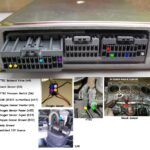A common issue for Dodge owners is the dreaded P0456 OBD2 code, which indicates a very small EVAP system leak. This problem can be frustrating to diagnose and repair, often leading to failed emissions tests and poor engine performance. This article will explore the causes, symptoms, and potential fixes for the P0456 code in Dodge vehicles.
Understanding the P0456 Code
The P0456 code specifically points to a very small leak in the Evaporative Emission Control (EVAP) system. This system is designed to capture fuel vapors from the gas tank and prevent them from escaping into the atmosphere. When a small leak occurs, the system can’t maintain proper pressure, triggering the P0456 code and illuminating the check engine light.
Common Causes of P0456 in Dodge Vehicles
Several components within the EVAP system can contribute to a P0456 code:
- Loose or Damaged Gas Cap: The most common culprit is often a loose, damaged, or missing gas cap. A properly sealed gas cap is crucial for maintaining pressure within the EVAP system.
- Faulty Purge or Vent Solenoid: These solenoids control the flow of fuel vapors within the system. A malfunctioning solenoid can lead to pressure leaks.
- Cracked or Damaged EVAP Lines: Hoses and lines within the EVAP system can crack or become damaged over time, allowing vapors to escape.
- Leaking Fuel Tank or Filler Neck: While less frequent, leaks in the fuel tank or filler neck itself can also trigger the P0456 code.
- Faulty EVAP Canister: The canister stores fuel vapors until they can be purged into the engine. A damaged or saturated canister can cause leaks.
- Leak Detection Pump: Issues with the leak detection pump or its associated components can contribute to a P0456 code.
Symptoms of a P0456 Code
While the illuminated check engine light is the primary indicator, other symptoms may accompany a P0456 code:
- Fuel Smell: A noticeable fuel odor, especially around the vehicle’s rear, can suggest a fuel vapor leak.
- Poor Fuel Economy: A small EVAP leak can sometimes lead to slightly decreased fuel efficiency.
- Rough Idle or Engine Performance: In some cases, a significant leak can disrupt the air-fuel mixture, leading to rough idling or poor engine performance, as seen with the chugging during acceleration described in the original owner’s experience.
Diagnosing and Fixing a P0456 Code
Diagnosing the specific cause of the P0456 code requires a systematic approach.
- Visual Inspection: Start by visually inspecting the gas cap, EVAP lines, and canister for obvious damage or loose connections.
- Smoke Test: A smoke test is a common diagnostic procedure used to pinpoint leaks in the EVAP system.
- Diagnostic Scanner: Using an OBD2 scanner can provide more detailed information about the code and help isolate the problem area.
Based on the original owner’s experience, replacing common components like the gas cap, purge valve, and leak detection pump hasn’t resolved the issue. This suggests a more persistent problem, potentially with the EVAP lines, canister, fuel tank, or filler neck. A thorough smoke test is highly recommended to locate the leak.
Conclusion
The P0456 code in a Dodge vehicle indicates a small EVAP leak that requires attention. While a loose gas cap is a common cause, more complex issues may be involved. A systematic diagnostic approach, including a visual inspection and smoke test, is essential to pinpoint the leak and ensure a successful repair. If you are experiencing this issue, consulting a qualified mechanic specialized in Dodge vehicles is recommended for proper diagnosis and repair.
